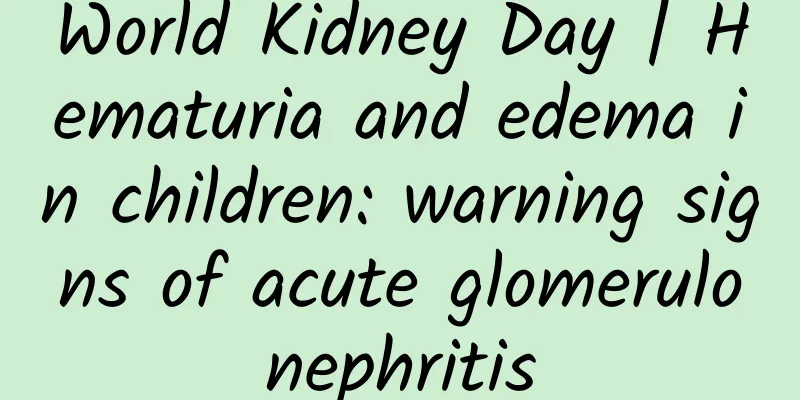World Kidney Day | Hematuria and edema in children: warning signs of acute glomerulonephritis

|
Hematuria and edema are common symptoms in children's health problems. Many parents often feel very nervous, anxious and confused when they find their children have these symptoms. Among them, acute glomerulonephritis is one of the main causes of hematuria and edema in children. ■ Symptoms of acute glomerulonephritis Acute glomerulonephritis refers to a group of glomerular diseases with different causes and acute onset of clinical manifestations, mainly hematuria and edema, accompanied by varying degrees of proteinuria, and may have hypertension and decreased renal function. It is common in children aged 5 to 14 years old, rare in children under 2 years old, and the male to female ratio is 2:1. It is usually caused by infection, immune response or other factors, especially after experiencing an upper respiratory tract infection. The occurrence of this disease is related to the immune system's response to infection, especially streptococcal infection, which is common after acute pharyngitis or skin infection. This disease can be divided into acute post-streptococcal glomerulonephritis and non-streptococcal post-glomerulonephritis. This article mainly popularizes acute post-streptococcal glomerulonephritis. The main symptoms include hematuria, edema, hypertension, changes in urine volume, proteinuria, and general discomfort such as fatigue, loss of appetite, and vomiting. ■ Diagnostic methods Diagnosis of acute glomerulonephritis usually requires a combination of infection history (especially streptococcal infection history), clinical manifestations and laboratory tests (increased titers of serum anti-streptolysin O and anti-DNase B antibodies, decreased serum total complement and C3, hematuria and proteinuria in urine tests, etc.) Patients with rapid disease progression, atypical clinical or laboratory tests, and prolonged disease may undergo renal puncture histopathological examination to confirm the diagnosis. Treatment 1. Rest: In the acute phase, patients with visible hematuria, hypertension, and obvious edema need to stay in bed. Patients can stay in bed until the visible hematuria disappears, blood pressure returns to normal, and renal function improves. Patients can then get out of bed and do some light activities. Patients can go to school if their ESR is normal, but should avoid strenuous physical activities. Physical activities can be resumed only after the urine sediment cell count returns to normal. 2. Eliminate the infection focus: If the doctor finds that there is still streptococcal infection, penicillin is generally the first choice for antibiotic treatment. If you are allergic, erythromycin can be used instead. The course of treatment is 5 to 7 days. 3. Symptomatic treatment: To control edema and hypertension, diuretics and antihypertensive drugs may be needed. 4. Dietary adjustment: A low-salt diet can help reduce edema, and limit protein intake if necessary. 5. Observation and follow-up: Acute glomerulonephritis in most children is self-limited, and regular follow-up can ensure that the disease is under control. ■ Notes for parents 1. Seek medical attention promptly: If your child is found to have hematuria or edema, it is recommended that you take your child to the doctor promptly for necessary examinations. It is recommended that the families of the sick children avoid blindly seeking medical attention on the Internet (if only hematuria is concerned, if accompanied by frequent urination, urgency, and pain, most of these are urinary tract infections; if only eyelid and facial edema is concerned, it has been found that children with infectious mononucleosis have this symptom prominently). 2. Pay attention to diet: Maintain your child's healthy eating habits and avoid high-salt, greasy and irritating foods. 3. Observe changes in symptoms : pay close attention to your child's urine volume, blood pressure changes and physical condition, and communicate with the doctor in a timely manner. 4. Enhance immunity: Through reasonable exercise and adequate sleep, children's immunity can be improved and the chance of infection can be reduced. (Author: Sun Penglei, Department of Pediatrics, Zhaotong First People's Hospital, Yunnan Province) |
<<: World Kidney Day | Scientific management strategies for renal cysts
>>: A light diet does not equal a vegetarian diet! Don’t misunderstand it anymore
Recommend
The relationship between ovulation and menstruation
If you have learned how to calculate the menstrua...
Menstruation was delayed for 20 days after weaning
After the newborn is born, under normal circumsta...
Bilateral adnexal cysts with clear borders of anechoic areas
The boundaries of the echo-free areas of bilatera...
What is the process of female ring insertion?
Nowadays, many people choose to use IUDs for cont...
Which ovarian care product is good?
Nowadays, many women pay special attention to the...
Why is it hard for a pregnant woman to breathe?
After a pregnant woman becomes pregnant, the baby...
There is a lump in the breast that hurts when pressed
Breasts are one of the female sexual characterist...
What should I do if my girlfriend has menstrual pain?
Girls will have their periods every month. Under ...
If you tear your eyes a lot in winter, this eye disease may be the cause!
Our eyes are one of the most delicate organs in t...
Women's health: the benefits and taboos of eating dates
Health experts explain the benefits and contraind...
What is pelvic effusion? Do you know these?
Pelvic effusion is a disease that some middle-age...
How long is the shelf life of pistachios? When do pistachios mature?
For those who like to eat pistachios, you may not...
What are the treatments for increased premenstrual leucorrhea?
Increased vaginal discharge is a very common dise...
Cervical Conization Cost
The cervix is a very important part of women, a...









